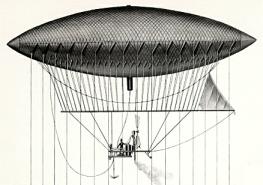Giffard Dirigible on:
[Wikipedia]
[Google]
[Amazon]
__NOTOC__
The Giffard dirigible or Giffard airship was an

Henri Giffard, « De la force dépensée pour obtenir un point d'appui dans l'air calme, au moyen de l'hélice. », ''Bulletin de la société Aérostatique et Météorologique de France'' (May 1853), Paris Gauthier-Villars 1853
in ''Collection de mémoires sur la locomotion aérienne sans ballons'' published by Gustave Ponton d'Amécourt, Gauthier-Villars, 1864, 58–62 {{Commons category 19th-century French experimental aircraft Airships of France Aviation history of France Steam-powered aircraft Hydrogen airships
airship
An airship or dirigible balloon is a type of aerostat or lighter-than-air aircraft that can navigate through the air under its own power. Aerostats gain their lift from a lifting gas that is less dense than the surrounding air.
In early ...
built in France in 1852 by Henri Giffard
Baptiste Jules Henri Jacques Giffard (8 February 182514 April 1882) was a French engineer. In 1852 he invented the steam injector and the powered Giffard dirigible airship.
Career
Giffard was born in Paris in 1825. He invented the injector an ...
, the first powered and steerable (french: dirigeable, directable) airship to fly. The craft featured an elongated hydrogen
Hydrogen is the chemical element with the symbol H and atomic number 1. Hydrogen is the lightest element. At standard conditions hydrogen is a gas of diatomic molecules having the formula . It is colorless, odorless, tasteless, non-toxic, an ...
-filled envelope
An envelope is a common packaging item, usually made of thin, flat material. It is designed to contain a flat object, such as a letter or card.
Traditional envelopes are made from sheets of paper cut to one of three shapes: a rhombus, a shor ...
that tapered to a point at each end. From this was suspended a long beam with a triangular, sail-like rudder
A rudder is a primary control surface used to steer a ship, boat, submarine, hovercraft, aircraft, or other vehicle that moves through a fluid medium (generally aircraft, air or watercraft, water). On an aircraft the rudder is used primarily to ...
at its aft end, and beneath the beam a platform for the pilot and steam engine. Due to the highly flammable nature of the lifting gas
A lifting gas or lighter-than-air gas is a gas that has a density lower than normal atmospheric gases and rises above them as a result. It is required for aerostats to create buoyancy, particularly in lighter-than-air aircraft, which include free ...
, special precautions were taken to minimise the potential for the envelope to be ignited by the engine beneath it. The engine's exhaust was diverted downwards to a long pipe projecting below the platform, and the area surrounding the boiler's stoke hole was surrounded by wire gauze
A wire gauze or wire mesh is a sheet of thin metal that has net-like patterns. Wire gauze is placed on the support ring that is attached to the retort stand between the Bunsen burner and glassware or is placed on a tripod to support the beakers, ...
. On 24 September 1852, Giffard flew the airship from the hippodrome
The hippodrome ( el, ἱππόδρομος) was an ancient Greek stadium for horse racing and chariot racing. The name is derived from the Greek words ''hippos'' (ἵππος; "horse") and ''dromos'' (δρόμος; "course"). The term is used i ...
at Place de l'Etoile to Élancourt
Élancourt () is a commune in the Yvelines department, and the Île-de-France region, north central France. It is located in the western suburbs of Paris, 30.6 km (19.0 mi) from the center of Paris, in the " new town" of Saint-Quentin- ...
, covering the in around 3 hours, demonstrating maneuvering along the way. The engine, however, was not sufficiently powerful to allow Giffard to fly against the wind to make a return journey.
Specifications

References
* *Bibliography
Henri Giffard, « De la force dépensée pour obtenir un point d'appui dans l'air calme, au moyen de l'hélice. », ''Bulletin de la société Aérostatique et Météorologique de France'' (May 1853), Paris Gauthier-Villars 1853
in ''Collection de mémoires sur la locomotion aérienne sans ballons'' published by Gustave Ponton d'Amécourt, Gauthier-Villars, 1864, 58–62 {{Commons category 19th-century French experimental aircraft Airships of France Aviation history of France Steam-powered aircraft Hydrogen airships